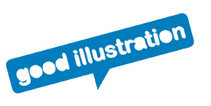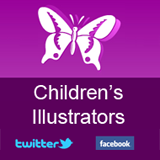What is your professional background and how did you end up as Design Director at Chronicle?
I have a degree in Fine Art, and went on to do an MA in Design where my thesis project focused on children’s book illustration and design. After finishing my education, I had my sights set on working in children’s books, and after internships in publishing in the UK and Canada, and working for a while as an art director for an ad agency in Canada, I came to San Francisco on a short contract with Chronicle to cover a maternity leave in the children’s design department. That was in 2000, and I’ve been at Chronicle ever since. I’ve been managing the Children’s design department for over two years now.
Could you outline a typical day as Design Director within the Children’s Department at Chronicle Books?
As I’m sure it does for so many others, my day usually starts with the glamour of email and returning phone calls – checking and responding to email from my in-house teammates, outside illustrators and freelance designers – materials are often submitted this way, and though some happens in person or over the phone, most of my communication with illustrators happens over email these days.
Generally, 1 or more hours a day is devoted to meetings of some kind – either creative development meetings with editors (to review materials) or with production coordinators (to discuss format, specs or proofs), meetings with illustrators (either potential ones or those we’re already working with), or administrative/departmental related meetings.
I generally spend some time each day reviewing sketches, galleys or proofs for my projects, and reacting to any “design emergencies” that might come up. I also spend at least a few hours every day on focused design research or layout or art direction work, since in addition to overseeing the department, I personally design or art direct between 10-15 titles per season.
On most days, I spend at least some time researching illustrators online or reviewing incoming illustrator samples (which come in daily by mail in the form of postcard mailers, emails and packets from representatives/agents) and file those that could be appropriate for future use. We also have a portfolio review that happens once a month where illustrators’, designers’ and photographers’ work is called in and is reviewed by designers from all of Chronicle’s publishing divisions (Adult Trade, Gift and Children’s)
On average, how many children’s books does Chronicle produce a year?
We currently publish anywhere between 70-90 children’s titles per year. Some of those are board books, some are picture books, some chapter books, and some are “books-plus” or novelty formats. In addition to that, the Chronicle Books Gift Division publishes numerous non-book titles for children each season such as guided journals, games, decks and stationery.
Tell us about 3 recent projects you have enjoyed working on and why.
Hmm . . . Do I have to pick just 3? One of my favorite things about my workload at Chronicle is how varied it is – how no project is ever the same, no illustrator ever works in exactly the same way, and I can be working on a picture book, a chapter book, a board book and a recipe box all at the same time. I also appreciate the privilege I’ve had of working both with incredibly seasoned illustrators such as Ed Young (Beyond the Great Mountains, 2005) – who should really be directing ME! – as well as extremely talented first time illustrators like Amanda Shepherd (Rules of the Wild, 2004) who are a joy to collaborate with and to watch blossom on a project. I like the technical challenge of working on more design-driven formats (My A to Z Recipe Box – illustrated by Melissa Sweet and coming in Spring 2007) as well as the more cerebral work of art directing picture books and coming up with the appropriate design concept/execution for them (An Egg is Quiet, illustrated by Sylvia Long, Spring 2006, Ivy + Bean, illustrated by Sophie Blackall, Spring 2006). I also love working with illustrators who come to a project already full of ideas – I had that kind of experience with Adam McCauley on Mark Schulman’s Mom and Dad are Palindromes (Spring 2006) – he had such a strong vision for the text right from the start, and managed to make it as much a learning tool about Palindromes, as it is a zany (and extremely attractive) picture book. I am always excited when an illustrator can really connect with a manuscript and bring a unique aesthetic vision to a project.
How many illustrators do you typically work with per year?
It’s difficult to give an exact number here, but I estimate that in the children’s department, on average, we work with approximately 50-70 illustrators each year – sometimes more, sometimes less, depending on what type of publishing we’re up to.
What can we expect from Chronicle Children’s Books in 2007?
You can expect the next instalments from our chapter book series launched in 2006 (Ivy & Bean, Hot Dog & Bob,Keeker), some fiction for older readers, some beautifully illustrated and executed non-fiction titles, and as always, some unique and distinctive picture books featuring some very accomplished illustrators, as well as some new, promising ones.
Within the last couple of years, which children’s book has been the most successful for Chronicle and what do you attribute to its success?
Though I am always working with my teammates towards the goal of making commercially viable publishing with strong critical attention, as an art director, there are other forms of “feedback” that I also like to consider when asking the question of whether a book is a success, such as awards from the art/design community, or specific mention of art/design in reviews. One of my hopes for Chronicle’s Children’s publishing is that it be recognized for it’s committment to a diverse and distinctive range of high-quality illustration and design. I am particularly excited when a book is not only a commercial success, but also meets those high standards for design and art direction. It’s terrific when a book is recognized for its aesthetic merits by more traditional children’s book venues as well as less expected venues. One such example that comes to mind is Little Pea, (the story of a vegetable who is forced to eat his candy for dinner, but would prefer to hold out for dessert – spinach) which is written by Amy Krouse Rosenthal and illustrated by Jen Corace – and has enjoyed strong commercial success as well as an excellent critical response (Book Sense Children’s Pick, Summer 2005; Kirkus, Starred Review; International Reading Association’s (IRA) Children’s Choices 2006). Additionally, it has had an excellent popular response (it has engendered much support and excitement both within Chronicle’s walls as well as with accounts) – and among other great publicity, was selected to be featured in a nation-wide ad campaign this spring for Banana Republic (featuring a close up image of a mother and child reading it) which was not only wonderful promotion for the book itself – but for reading with children in general.
I like to think that the success of this book has had to do not only with the fact that it’s a delightfully clever and humorous text, but that Jen Corace’s illustrations are unique and distinctive, yet refreshingly simple and pared down to the essentials. I also think there is something perennially appealing about a cute, round, little green pea (especially the one that Jen has created here, with his sweet, playful face) – the title evokes terms of endearment used for children like “sweet pea” and for friends and family like “peas in a pod”. I think humor has been very important to the success of this book, and the physical humor of imagining how a pea would play in the schoolyard, or get a piggyback from his dad is spot-on.
How much influence do the Sales / Marketing departments have over your work?
There are two ongoing forums for Sales/Marketing involvement in creative development – one of them is our acquisitions board, where the sales and marketing group weighs in on what titles we should publish (based on how commercially viable they are), and any special concerns for their publication (often there will be some illustration or design directive that they communicate at that time – such as, it has to be different from this, or it needs to be a certain trim size/page count, or it needs to have a certain perceived value). The second forum is our cover meeting. As the main vehicle for marketing the book, we take our cover designs very seriously at Chronicle, and invite the Sales and Marketing groups to weigh in at various stages of the development of a cover to ensure that the direction the book is going is will help us to achieve the goals we set out to accomplish when the original decision to publish the project was made.
The sales and marketing group are our partners and consultants – a liaison to the marketplace – with whom editors and designers have an ongoing conversation – and there is mutual respect for the expertise that each party brings to the table. So, I guess to answer the question, the sales/marketing group has as much influence as they need to, in any given situation.
Do you work with many illustrators from outside the U.S?
Yes, we do work with illustrators outside the U.S. – though not as many as those IN the U.S. Depending on the title, it can be more convenient when illustrators are in the United States, as it makes it easier for promoting their books (tours, etc.). But the foremost goal is always to find the right person for the job, and if they happen to live outside the United States, we try to just work out the rest.
Do you have a personal favourite picture book?
Too many to mention here! But I have always been a big fan of Leo Leonni – both as a childhood reader, and now as an art director. There is a wonderful warmth to his characters, and brilliantly simple details such as how he distinguished between Alexander and the Wind-Up Mouse (in the book of the same title) by using torn paper (with a rough, organic edge) for the real mouse, and cut paper (with a hard/smooth edge) for the mechanical mouse. Simple yet potent details like that are perceived and interpreted beautifully by young readers, and his books have certainly inspired me to encourage illustrators to emphasize what is essential in each image they create.
I generally gravitate towards books that are more on the minimal side, where those minimal details strategically pack in a lot of expression and narrative.
Aside from their obvious talent, what personal qualities do you look for when choosing an illustrator to work with?
Aside from talent, appropriateness for the manuscript, and ability to create engaging characters, it’s got to be enthusiasm for the project and excitement about collaboration – that goes an awfully long way with me!
This interview has been syndicated courtesy of Childrensillustrators.com







